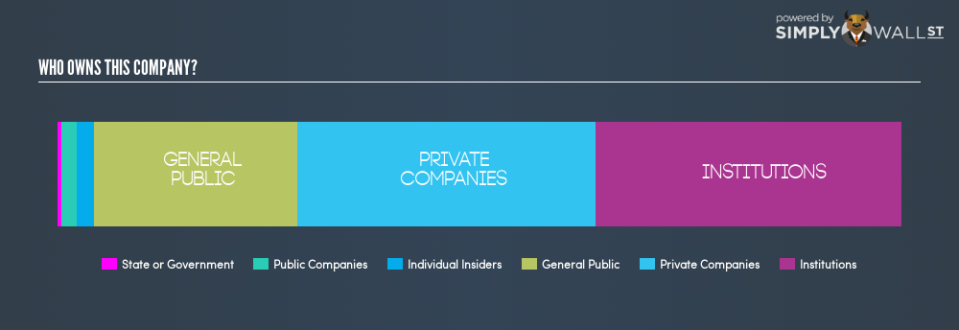Who Owns Most Of KEC International Limited (NSE:KEC)?

In this article, I’m going to take a look at KEC International Limited’s (NSE:KEC) latest ownership structure, a non-fundamental factor which is important, but remains a less discussed subject among investors. Ownership structure of a company has been found to affect share performance over time. Differences in ownership structure of companies can have a profound effect on how management’s incentives are aligned with shareholder returns, and whether they adhere to corporate governance best practices. Although this is an important factor for long-term investors, many investors can also be impacted by institutional presence and their high-volume trading. Therefore, I will take a look at KEC’s shareholders in more detail.
View our latest analysis for KEC International
Institutional Ownership
KEC’s 36.2% institutional ownership seems enough to cause large share price movements in the case of significant share sell-off or acquisitions by institutions, particularly when there is a low level of public shares available on the market to trade. Although KEC has a high institutional ownership, such stock moves, in the short-term, are more commonly linked to a particular type of active institutional investors – hedge funds. For shareholders in KEC, sharp price movements may not be a major concern as active hedge funds hold a relatively small stake in the company. Although this doesn’t necessarily lead to high short-term volatility, we should dig deeper into KEC’s ownership structure to find how the remaining owner types can affect its investment profile.
Insider Ownership
Insiders form a group of important ownership types as they manage the company’s operations and decide the best use of capital. Insider ownership has been linked to better alignment between management and shareholders. KEC insiders hold a not-so-significant 2.0% stake in the company, which somewhat aligns their interests with that of shareholders. However, a higher level of insider ownership has been linked to management executing on high-returning projects instead of expansion projects for the sake of apparent growth. In addition to this, it may be interesting to look at insider buying and selling activities. Keep in mind that buying may be sign of upbeat future expectations, but selling doesn’t necessarily mean the opposite as the insiders might just be doing it out of their personal financial needs.
General Public Ownership
A substantial ownership of 24.2% in KEC is held by the general public. This level of ownership gives retail investors the power to sway key policy decisions such as board composition, executive compensation, and potential acquisitions. This is a positive sign for an investor who wants to be involved in key decision-making of the company.
Private Company Ownership
Potential investors in KEC should also look at another important group of investors: private companies, with a stake of 35.3%, who are primarily invested because of strategic and capital gain interests. This kind of ownership, if predominantly strategic, can give these companies a significant power to affect KEC’s business strategy. Thus, potential investors should look into these business relations and check how it can impact long-term shareholder returns.
Next Steps:
The company’s high institutional ownership makes margin of safety a very important consideration to existing investors since long bull and bear trends often emerge when these big-ticket investors see a change in long-term potential of the company. This will allow investors to reduce the impact of non-fundamental factors, such as volatile block trading impact on their portfolio value. However, if you are building an investment case for KEC, ownership structure alone should not dictate your decision to buy or sell the stock. Rather, you should be looking at fundamental drivers such as the intrinsic valuation, which is a key driver of KEC International’s share price. I urge you to complete your research by taking a look at the following:
Future Outlook: What are well-informed industry analysts predicting for KEC’s future growth? Take a look at our free research report of analyst consensus for KEC’s outlook.
Past Track Record: Has KEC been consistently performing well irrespective of the ups and downs in the market? Go into more detail in the past performance analysis and take a look at the free visual representations of KEC’s historicals for more clarity.
Other High-Performing Stocks: Are there other stocks that provide better prospects with proven track records? Explore our free list of these great stocks here.
NB: Figures in this article are calculated using data from the last twelve months, which refer to the 12-month period ending on the last date of the month the financial statement is dated. This may not be consistent with full year annual report figures.
To help readers see past the short term volatility of the financial market, we aim to bring you a long-term focused research analysis purely driven by fundamental data. Note that our analysis does not factor in the latest price-sensitive company announcements.
The author is an independent contributor and at the time of publication had no position in the stocks mentioned. For errors that warrant correction please contact the editor at editorial-team@simplywallst.com.

 Yahoo Finance
Yahoo Finance 
